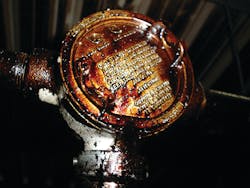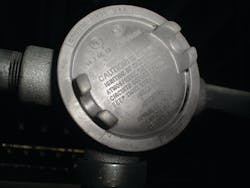Dry ice cleaning: Offering solutions in the oil & gas industry
Dry ice cleaning is an innovative cleaning technology that can save both time and money in the oil and gas industry.
It is like sand, bead and soda blasting in that it cleans surfaces using a media accelerated in a pressurized air stream. But it differs because dry ice cleaning uses solid CO2 pellets or MicroParticles, which are blasted at supersonic speeds and sublimate (turn from solid to gas) upon impact, lifting dirt and contaminants off the underlying substrate.
Traditional cleaning methods are time-consuming, labor intensive and costly. Manual scraping or scrubbing with wire brushes and water or chemicals can consume many hours and result in extended downtime.
The unique characteristics of dry ice make it the perfect media for a clean-in-place process in the oil and gas industry.
No secondary waste
Dry ice sublimates upon impact with the surface being cleaned, which means no secondary waste, no residue and no moisture is being generated. This eliminates the added costs of extra cleanup, the disposal of a secondary waste stream and additional cleaning preparation, such as wrapping equipment prior to cleaning. The cleaning process does not use water, which allows equipment to be cleaned while online and still operating. It also allows for electrical and mechanical equipment to be cleaned without damage.
Non-toxic
Dry ice cleaning is safe and non-toxic. It eliminates the need to use environmentally harmful cleaning chemicals and reduces or eliminates worker exposure to dangerous chemical cleaning agents. It contains no secondary contaminants and does not create downstream contamination or produce toxic waste that must be disposed of.
Non-abrasive and non-conductive
Dry ice will not damage surfaces or equipment. It is a very soft media and can clean sensitive equipment and surfaces without etching, profiling or changing surface dimensions. The dry ice cleaning process will not damage equipment like other blasting methods such as grit and hydro blasting can. It also removes the potential for foreign grit contamination to sensitive moving parts. Dry ice cleaning extends equipment life by eliminating the need for harsh chemicals, wire brushes and abrasive pads and allows for increased cycles between preventative maintenance.
As the ultimate clean-in-place tool, dry ice minimizes disassembly and pre-job preparation time – and equipment can be cleaned without dismantling or relocation of tooling to other areas.
Applications within the oil & gas industry
Dry ice makes cleaning easier and more complete and enables oil and gas companies to quickly and easily clean a number of surfaces. It provides a faster and more effective cleaning solution when compared to other methods. The speed of cleaning reduces production downtime while cleaning performance enhances efficiencies.
It is a proven solution for cleaning many different types of equipment without the risk of damaging the surfaces. Dry ice cleaning is effective in cleaning heat exchangers, generators, radiator fins, motors, pumps, vessels, drilling equipment, boiler tubes, tank batteries and other oil and gas equipment.
Dry ice is gentle enough to clean radiator fins on fracking pump trucks, aggressive enough to clean heavy oils, hydrocarbons and thick tars like Bitumen, and effective enough to be able to inspect pipelines or instruments thoroughly. It also promotes better non-destructive testing results and wet florescent magnetic particle inspections.
Efficiency is key in oil and gas processing, and dry ice cleaning offers the most efficient cleaning process. It allows for reduced shutdown and improved efficiency for heat exchangers, generators and radiators when shaved MicroParticles are used to remove surface contaminants. Dry ice cleaning can clean this equipment in place and enables the cleaning of the intricate cavities that other methods cannot reach.
Other cleaning methods — such as chemical foam and pressure washing — require extensive drying time, while abrasive blasting causes damage to equipment. With these processes, parts must be disassembled and soaked in a cleaning agent for several hours to become clean, and they then take days to dry. With dry ice cleaning, equipment can be cleaned in place without damage.
Due to the gentle cleaning capabilities of dry ice, there is no risk of damage to electrical or sensitive equipment, valve packing, vessel internals and other delicate surfaces.
The process is also safer than other cleaning methods. Methods that use chemicals can be harmful to workers and can also harm the equipment over time. The risk of fire is also dramatically reduced when dry ice cleaning is used to clean spilled hydrocarbons, asphaltene, coke, heavy oils, paraffin, Sulphur, carbon and other contaminants from loading areas.
Due to the unique properties of dry ice, it can help oil and gas companies achieve operational efficiencies in their cleaning process.
Operation efficiencies within oil & gas
Improved processes
With dry ice cleaning, oil and gas companies can do more with less. It enables the streamlining of cleaning and maintenance processes while reducing the cost impact of these processes. Rather than shutting down operations and disassembling and manually cleaning the machinery, equipment can be cleaned while it is still hot and online.
Dry ice cleaning also allows companies to use fewer workers in their cleaning processes. Labor costs can be significantly reduced by cutting man-hours, and workers can be reallocated to other operational areas.
Increased overall productivity
Dry ice cleaning has proven to increase the productivity of oil and gas companies. Cleaning can take place without disassembling equipment or completely shutting down operations, which saves the time and energy it would have taken to cool, disassemble and re-assemble equipment.
The process also reduces the need for hand tools, which significantly slow the cleaning process and cause damage to equipment and surfaces.
Prolonged equipment life
Unlike other cleaning media, dry ice is non-abrasive and non-conductive. Cleaning with dry ice helps to eliminate the damage caused to equipment by the chemicals and tools traditionally used to clean them.
Reduced waste
Manual cleaning processes use chemicals that produce secondary waste. Other blasting solutions — such as water, sand or bead blasting — require significantly more containment measures to help reduce the impact of their blast media. In addition, when using water or solvents, the materials used in cleaning and the remnants of what is being cleaned contaminate the wastewater. The water must then be treated as toxic waste and be properly disposed of.
Support of environmental initiatives
Dry ice cleaning is an environmentally responsible cleaning process that supports green initiatives. The process eliminates the need for water or chemical solvents and, because it does not produce any secondary waste, also reduces the possibility of downstream contamination.
David Watson is the director of business development for contract cleaning for Cold Jet, LLC. Cold Jet manufactures and distributes dry ice cleaning and dry ice production equipment worldwide.
Case Study
Dry ice blasting effectively cleans the surfaces of train wagons used in the transportation of petroleum
TüPRAS, which was founded in 1972, is the only manufacturer in the refining sector in Turkey and has the capacity to process 28.1 million tons of crude oil annually with its four refineries in Izmit, Izmir, Kırıkkale and Batman. It is the largest industrial company in Turkey and the seventh-largest refining company in Europe. The company transports its heavy petroleum products in railway wagons, and the wagons are used on a regular and demanding schedule to maintain the company’s efficient and steady output.
The problem
To continue the transportation of petroleum products in accordance with safety regulations, the wagons carrying the heavy petroleum products had to be cleaned for the first time. TüPRAS had to come up with a solution that would clean the contamination that had built up over 10 years on its 149 wagons. An important condition was that the cleaning had to be done without harming the environment. The cleaning also needed to avoid any risks associated with fire in the refinery, thus eliminating many cleaning options associated with chemical cleaners.
The solution
TüPRAS needed a cleaning method that would reduce maintenance time and avoid hazardous chemicals to get the wagons back on their normal delivery schedule. Dry ice blasting was the solution.
Dry ice blasting is an air-powered media blasting system that uses solid carbon dioxide (CO2) in place of other chemicals. Unlike other blasting techniques, dry ice sublimates (converts from solid to gas) upon impact with the surface being cleaned, leaving no residue behind other than what was removed during the cleaning process. This results in a cleaning technique that is safe and non-toxic, does not create further contamination and reduces or eliminates exposure to dangerous chemical cleaning agents. It is a non-abrasive medium that uses the combination of kinetic energy and thermal effects to break the connection between the dirt and surface, lifting away contaminants.
In 2018, TüPRAS bought a Cold Jet blasting machine, the Aero 40FP, after a successful test in the Izmit plant. It has been used since to clean wagons that transport petroleum products for the Kırıkkale Refinery. Using dry ice blasting, all the railway wagons were cleaned for the first time. For this massive project, the company used four Aero 40FP dry ice blasters in two scaffolds. The job was successfully completed by 13 employees, who worked in two shifts, six days a week. It took them six months to clean the 149 wagons, with a total of 230,000 kg of dry ice used during the cleaning process. The deep clean has made maintenance on the wagons significantly easier for the company’s maintenance team. The maintenance team can now focus on other tasks, while the major cleaning is done in a more efficient way.
The results
The dry ice blasting solution has reduced maintenance time, costs and the use of chemicals during the cleaning of the wagons – while avoiding danger of open fire in the refinery. The cleaned wagons became operable again quickly and transportation of petroleum products could start up again on a normal schedule.





